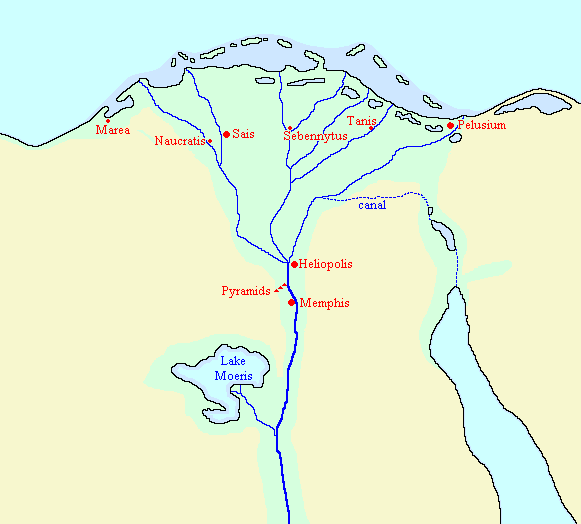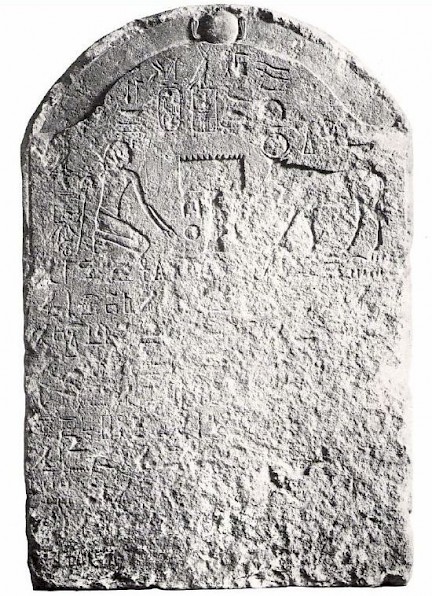Cambyses II (2)
Cambyses: second king of the ancient Achaemenid Empire (ruled 530-522). In 525, he conquered Egypt.
The madness of Cambyses

Although Cambyses had reduced the temple taxes, he did his best to behave as an Egyptian pharaoh. This is proven by the autobiography of Wedjahor-Resne, one of the few contemporary documents. He also made a wise decision when he appointed Aryandes as satrap of Egypt. This man ruled the country for more than twenty years, and possible almost thirty.
The Greek researcher Herodotus, living almost a century after the conquest of Egypt, offers a completely different picture. In his view, Cambyses' behavior is almost criminal. He gives a complete catalogue of evildoings. In Sais, he had violated the corpse of Amasis:
When Cambyses had entered the palace of Amasis, he gave command to take the corpse of Amasis out of his burial-place. When this had been done, he ordered [his courtiers] to scourge it and pluck out the hair and stab it, and to dishonor it in every other possible way. When they had done this too, they were wearied out, for the corpse was embalmed and held out against the violence and did not fall to pieces. Cambyses gave command to consume it with fire, a thing that was not permitted by his own religion. The Persians hold fire to be a god and to consume corpses with fire is by no means according to the Persian or Egyptian custom.note
According to Herodotus, this happened almost immediately after the conquest of Egypt, in the summer of 525. A new sacrilege was committed after the expedition to Upper Egypt: Cambyses killed the Apis bull. This was a manifestation of the god Ptah and therefore a sacred animal. After the death of the Apis bull, the priests started to search for a new Apis, and when they had found it, every Egyptian joined the celebrations.
When Cambyses arrived at Memphis, Apis appeared to the Egyptians [...] and they began to wear their fairest garments and organized festivities. Cambyses saw the Egyptians doing thus and supposed that they were rejoicing because he had fared ill. Therefore, he called for the officers who had charge of Memphis, and when they had arrived, he asked them why the Egyptians had done nothing of this kind when he was at Memphis on the former occasion, but were now, when he came there after losing a large part of his army, very glad. They said that a god had appeared to them [...] and that whenever he appeared, they all rejoiced and kept festival. Hearing this Cambyses said that they were lying, and as liars he condemned them to death.note

After the execution, Cambyses called the priests and the sacred bull into his presence.
When the priests brought Apis, Cambyses -being somewhat affected with madness- drew his sword, and aiming at the belly of Apis, struck his thigh. Then he laughed [...] and ordered those whose duty it was to do such things, to scourge the priests without mercy, and to put to death any one of the other Egyptians whom they should find keeping the festival. Thus the festival of the Egyptians was brought to an end, the priests were chastised, and Apis [...] lay dying in the temple. When he had died because of the wound, the priests buried him without the knowledge of Cambyses.note
Egyptologists have refuted Herodotus' story. It is a fact that an Apis bull died in September 524, but he received a normal burial in the Serapeum at Saqqara (near Memphis). The funeral monument shows Cambyses worshipping the divine bull.
The next crime on Herodotus' list is the killing of his brother Smerdis. We have already seen above that this happened before Cambyses went to Egypt. Herodotus' claims that Cambyses' next victim was the son of one of his courtiers, Prexaspes. Twelve Persian noblemen were buried alive, courtiers were executed, statues of Egyptian gods were ridiculed. Herodotus concludes with a remark that this last crime shows that Cambyses was completely out of his mind, because only a madman would mock the ancient laws and customs of a foreign country (text).
Madness?
This conclusion tells a lot about Herodotus, who had great respect for foreign cultures. The question is what its says about Cambyses, and the answer is: nothing. Herodotus is interested in the moral aspect of his story and did not check his spokesmen, the Egyptian priests who had, as we have already seen above, every reason to hate the Persian king.
However, it is too easy to conclude that Cambyses' behavior was completely normal and Herodotus is simply mistaken. The Apis was buried comparatively late, which may suggest that something unusual had happened. Many inscriptions mentioning Amasis were damaged, and although we do not know why and when, it certainly makes sense if we assume that Cambyses wanted to eradicate Amasis' reign. We simply do and cannot know what happened in Egypt between 525 and 522.
Death
Herodotus and the Behistun inscription agree that Cambyses' stay in Egypt was interrupted in the spring of 522 by the news that a Magian named Gaumâta had seized power in the Achaemenid empire, claiming to be Smerdis. (Gaumâta could do this, because the real Smerdis had been killed secretly.) According to the Behistun inscription:
When Cambyses had departed into Egypt, the people became hostile, and the lie multiplied in the land, even in Persia and Media, and in the other provinces. Afterwards, there was a certain man, a Magian, Gaumâta by name, who raised a rebellion in Paishiyâuvâdâ, in a mountain called Arakadriš. On the fourteenth day of the month Viyaxananote did he rebel. He lied to the people, saying: "I am Smerdis, the son of Cyrus, the brother of Cambyses." Then were all the people in revolt, and from Cambyses they went over unto him, both Persia and Media, and the other provinces. He seized the kingdom; on the ninth day of the month Garmapadanote he seized the kingdom. Afterwards, Cambyses died uvamaršiyuš.
The word uvamaršiyuš means "his own death". Nobody knows how to understand this: some scholars have argued that Cambyses died of natural causes, others maintain that it means suicide. The first alternative appears to be the better one.
Herodotus offers no real help. He tells that Cambyses, on hearing the news of the rebellion, rushed back to Persia. But when he jumped into the saddle of his horse, the cap fell of the sheath of his sword and exposed the blade, which pierced his thigh. The Greek historian does not fail to stress that this was just the spot where Cambyses had wounded the Apis. According to Herodotus, the Persian king died not much later. This is clearly a fairy tale.
Succession
The last letter that is dated to Cambyses' reign was written on 18 April 522. It was found in Babylon, and it merely proves that Gaumâta was recognized as king in April or May. Cambyses probably was still alive. He may have died in July. The court official with the title of arštibara, "lance carrier", must have replaced him as commander. His name was Darius son of Hystaspes.
According to both Herodotus and the Behistun inscription, Darius and six noblemen killed the Magian Gaumâta on 29 September 522. The first regnal year of the new king saw nineteen battles in an intense civil war, but at the end of that long but single year, Darius was victorious and was recognized as the true successor of Cyrus the Great and Cambyses.
There has been some speculation whether the stone structure at Takht-e Rostam was Cambyses' tomb. However, from the Persepolis Fortification Tablets, we know that he was venerated in Pasargadae. In a press release dated 13 December 2006, the Iranian Heritage Organization announced that the entrance to the tomb of Cambyses had indeed been identified near Pasargadae.